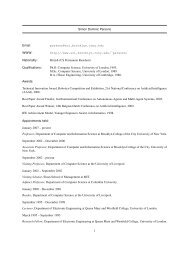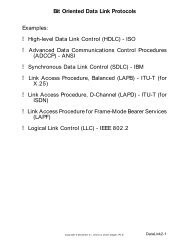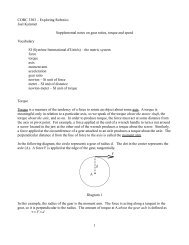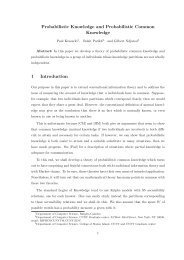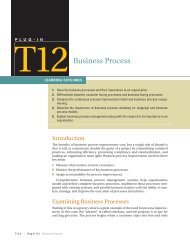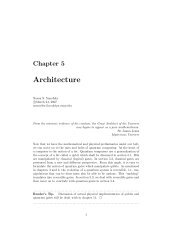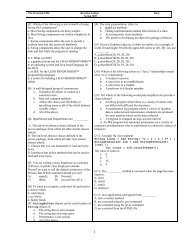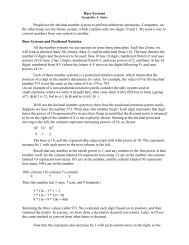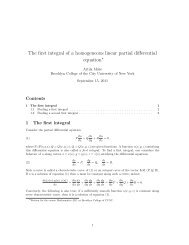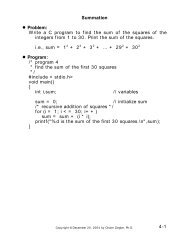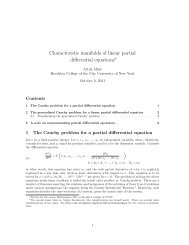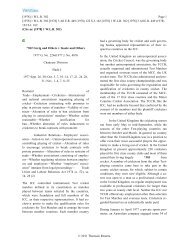Toward a Unified Theory of Human-Agent Modeling: A Position Paper
Toward a Unified Theory of Human-Agent Modeling: A Position Paper
Toward a Unified Theory of Human-Agent Modeling: A Position Paper
You also want an ePaper? Increase the reach of your titles
YUMPU automatically turns print PDFs into web optimized ePapers that Google loves.
data we studied, students responded to a subset <strong>of</strong> 7-8 questions, out <strong>of</strong> 94. A<br />
student’s pattern <strong>of</strong> right and wrong answers governed her “trajectory” through<br />
the assessment landscape (i.e., the subset and sequence <strong>of</strong> questions answered).<br />
We built agent-based models <strong>of</strong> students from logs that recorded 117 students’<br />
answers to questions in the assessment, and experimented with two different<br />
measures for clustering the training sets. One method was to create a 94element<br />
feature vector in which each question was encoded as “right”, “wrong” or<br />
“not seen” and classify students based on the Euclidean distance between feature<br />
vectors. The second method was to measure the distance between trajectories in<br />
the landscape using the Hausdorff geometric distance measure [21]. We applied<br />
a hierarchical clustering technique to both measures, generating two different<br />
partitions <strong>of</strong> student transaction logs. Then we trained agents to emulate the<br />
outcomes <strong>of</strong> the students in each group. The agents were represented using probabilistic<br />
influence networks [3], and were evaluated by deploying in a simulated<br />
version <strong>of</strong> the educational assessment and logging answers. We compared the<br />
correlation between trainee-trainer pairs resulting from each clustering measure,<br />
indicating how closely the trainees replicated the question-answering behavior <strong>of</strong><br />
their trainers. Our results showed that the trajectory-based clustering produced<br />
superior correlation to the feature-based clustering. We believe this is because<br />
the trajectory method takes into account the sequence and dependencies between<br />
questions, whereas the feature method views questions independently.<br />
In follow-on work to the SimEd classroom project, we simulated learning in<br />
groups <strong>of</strong> human students [7]. Based on multiple pedagogical theories <strong>of</strong> group<br />
learning, we engineered a model in which simulated students are presented with<br />
concepts (as in [6]) and interact in groups in order to acquire the concepts.<br />
We experimented with different compositions <strong>of</strong> “low” and “high” ability learners<br />
in groups and different reward structures (“individual”, “competitive” and<br />
“cooperative”), to determine the combination that produced the best results in<br />
terms <strong>of</strong> acquisition <strong>of</strong> more concepts by more students. The competitive and<br />
cooperative reward structures assigned the same reward to all members <strong>of</strong> the<br />
group based on how the group performed in relation to other groups. The results<br />
demonstrated that cooperative reward structures help low ability learners<br />
progress as part <strong>of</strong> a heterogeneous group more rapidly than other reward structures<br />
or homogeneous group assignments. This mirrors reports in pedagogical<br />
literature that describe observations <strong>of</strong> human classrooms.<br />
4 <strong>Modeling</strong> the process <strong>of</strong> individuals’ behaviors<br />
Although we have primarily focused on constructing models that emulate the<br />
outcomes <strong>of</strong> human behaviors, some <strong>of</strong> our more recent work has involved emulating<br />
the process <strong>of</strong> humans selecting actions (i.e., model type IV). In our MBTI<br />
project [8, 22], we apply the Myers-Briggs Type Indicator theory <strong>of</strong> human personality<br />
[23] to agents acting in a simple artificial life environment [24]. This theory<br />
defines human personalities along 4 axes: extroversion versus introversion;<br />
sensing versus intuition; thinking versus feeling; and judging versus perceiving.



